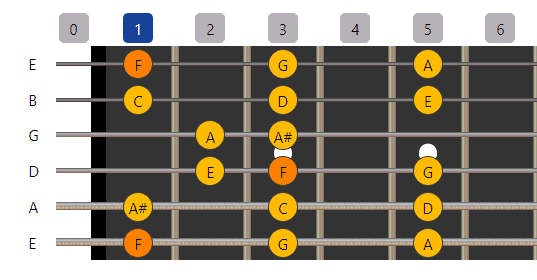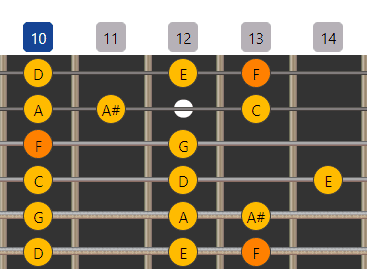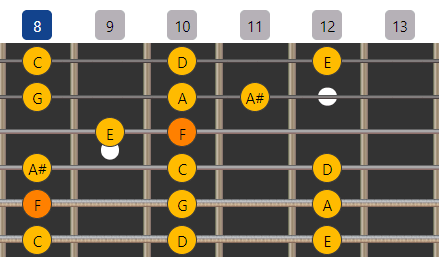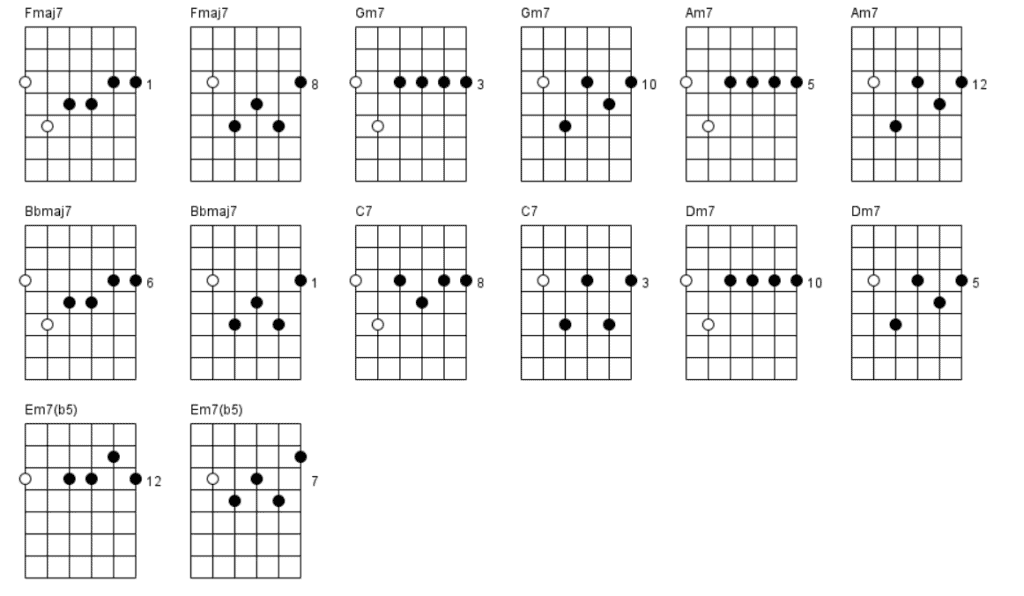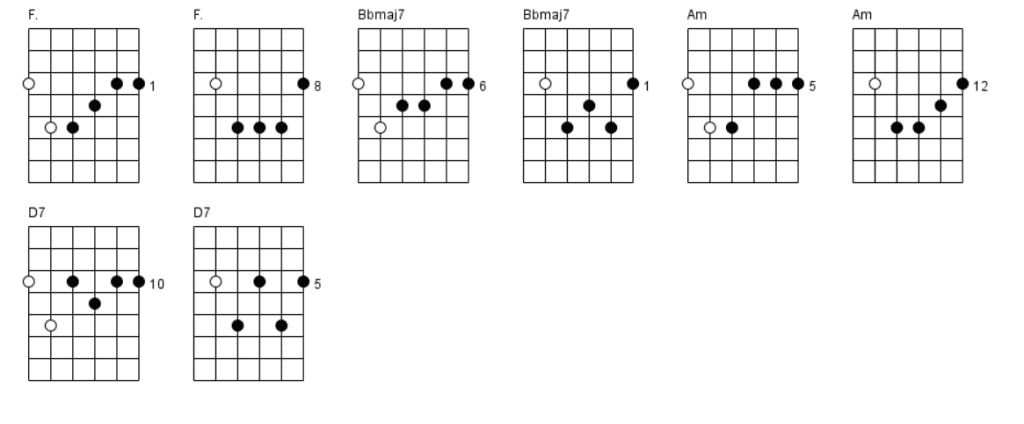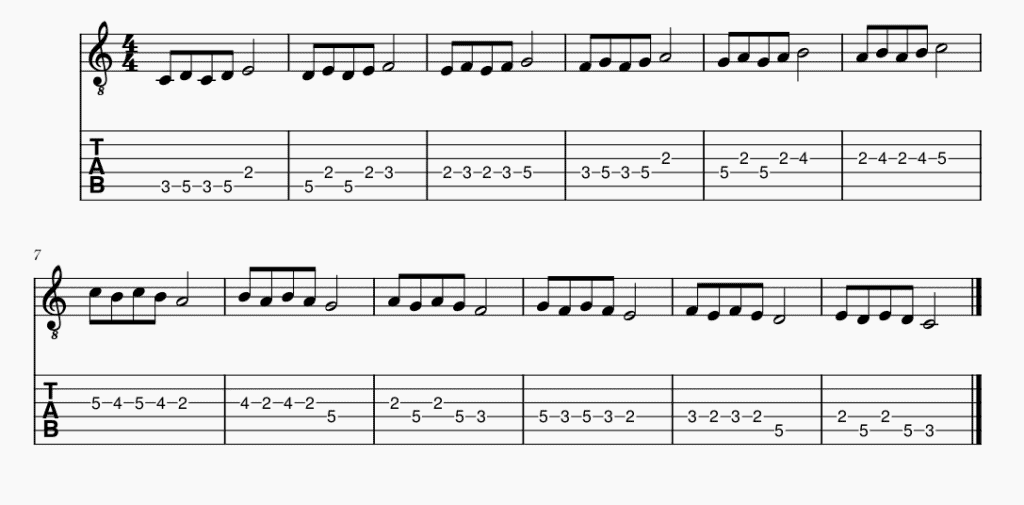Scales are considered one of the most fundamental concepts in music. These are a subset of notes out of the 12 notes found in western music. There are different types of scales based on the number of notes they contain as well as the mood they create based on the intervals they contain. So what are intervals?
Intervals are nothing but the pitch distance between any two notes. This is a really important concept as we will be defining the scales in terms of intervals.
Based on the number of notes the scale contains, the most commonly found scales are pentatonic(5 notes), hexatonic(6 notes), heptatonic(7 notes), Octatonic(8 notes). Out of these the pentatonic and hexatonic scales are most commonly used in music across the world. The major scale that we are about to learn is a heptatonic scale and how it is built will be covered in the next section.
Now let’s come to the question, why is it important to learn scales?
- Scales can be used as a basis for writing music because notes from a single scale generally will sound good together and help us musicians create good songs
- It will help us build knowledge of the fretboard and memorizing the notes on the fretboard.
- Scales can be used to create various technical exercises which will help us build our own lick library
Contents
F major scale theory
Guitar music theory in general, is based on 12 notes. The distance between any two notes is called an interval. All the scales are built using a combination of these intervals. These intervals are what gives a scale its characteristic feel. Generally, a major scale is said to have a very characteristically happy sound which may sometimes border on cheesy if not used properly.
But there is a reason that major scales are arguably the most used scales in songs and some of them are biggest hits. Though it has that happy and cheerful sound, some beautiful things can be done with this most basic scale. By calling it basic I mean that this can literally serve as a basis to learn almost all scales. Be it minor scales, different modes of scales or more exotic scales, most of them can be derived by making simple changes to the major scale. Thus it is very important to learn the theory behind how a major scale is built to use it in the most efficient way possible.
Now let’s take a look at how to build a major scale.
The formula of a major scale is R-W-W-H-W-W-W-H where R represents that root note of the scale, W represents a Whole step also known as a tone and H represents a half step also known as a semitone. This scale uses one flat note that is the Bb. This is the only note that is different from our classic all time favorite scale of musicians that is C major scale.
To build a F major scale, we take this formula and apply it to the F root note. This will give us the following notes:
| F | G | A | Bb | C | D | E | F |
How to play F major Scale on guitar
There are a huge number of ways in which you can play the F major scale on the guitar. All you need to know is the notes that form the F major scale and location of these notes on a guitar fretboard. To help you visualize the complete scale take a look at the following image. If you want to learn the F major scale, you can start with any of the F and play one or two octaves of the scale by moving onto different strings and positions.
But to give you a head start there are some shapes that you can learn to get the feel for the scale. But I urge and request you to not get stuck in these box shapes and explore the entire range of the guitar. In later sections we will look at how we can use these shapes to improvise over a backing track.
Single string Shape:
To get a feel for the scale, it is very important to get familiarized with the intervals of the scale. And to get a feel of the intervals, nothing can beat the practice of playing the scale on a single string. Playing a scale on a single string will help you to visualize the building formula for a major scale while helping you memorize the notes of the scale. It will also familiarize you with the intervals and placement of root notes on the fretboard.
So here is a one string shape on the E string:
Now try to build the scale on all the strings one by one.
Box Shapes:
Box shapes can be a really good place to practice the scale. You can practice this scale shape to build your speed and it will also help you see the patterns on the fretboard. We will take a look at some exercises to help you internalize the scale in a later section. A major advantage of learning these shapes is that you can transpose it to any fret. That is if you play the same shape starting on a different fret it will give your major scales with other root notes.
- Shape 1 Open Shape
- Shape 2 First Position
- Shape 3
- Shape 4
Connecting shapes
Once you are familiar with the scale and can play it up and down in the box shape, you can start to connect the shapes. Being stuck in a box can hinder your growth as a guitar player. So ideally an advanced guitarist should be able to play the scale all over the fretboard. But that is the end goal. What you can do to give yourself a chance to get out of the scale box is to connect various shapes of the scale. This can be very frustrating at the beginning and you will play wrong notes often. But remember that frustration means that you are learning something. Take things slow and you will be able to play like you always imagined.
Some examples of how you can connect different shapes are:
- Shape 1
- Shape 2
F major scale on whole Fretboard
Scale degrees
Different notes of the scale are given different names based on their position as well as the function. So in a F major scale, the scale degrees are:
- F (Tonic): F is the root note of the scale. It is the note that sounds like the “home note”. The complete scale is built on this founding note and we will return to this note frequently.
- G (Supertonic): It is the second note of the scale and forms a major second interval with the root note F.
- A (Mediant): F is called the mediant because it is the middle note of the chord built on the root note that is the F major chord. A forms a major third interval with the root note F.
- Bb (Subdominant): It is one of the most important scale degrees. It is named subdominant because it lies in the perfect fifth interval below the tonic. It forms a perfect fourth interval with the root note F.
- C (Dominant): This note can be considered the most important note in a scale after the root note. This is because classically this scale degree is used for a satisfying resolution of a musical phrase to the tonic. It forms a perfect fifth interval with the root note F.
- D (Submediant): It is the sixth scale degree. It forms a major sixth interval with the root note F.
- E (Leading tone): It is the seventh scale degree and it forms a major seventh interval with the root note F. It is one half step below the root note and acts as a leading tone to move back to our root note.
Chords in F major Scale
- Diatonic Chords
If we build a chord on every note of the scale by taking two more notes that lie in an alternate fashion in a scale, we will get the diatonic chords. In other words,
All scales have chords that can be formed using only the notes of the chosen scale. In the key of F major, we can build a total of 7 triad chords, each chord based on a different note of the scale. These are called diatonic chords.
To build these chords we will consider the scale in ascending order. After that we will select a root note on which the chord will be built. Now in the final step, we will choose two other notes. Omit a note after the root and select the one after that. Then again omit a note and select the one after that. This will give us our triad for any selected note of the scale.
For example, if you want to build a triad on the note A(3rd note of the scale) then in the scale of F major (F-G-A-Bb-C-D-E), select note A, omit note Bb, select note C, omit the D and finally select E. This gives us the A minor triad.
If you do this for every note of the scale then you will get following results
| Root note | Chord notes | Type of Chord |
| F | F-A-C | Major Chord |
| G | G-Bb-D | Minor chord |
| A | A-C-E | Minor Chord |
| Bb | Bb-D-F | Major Chord |
| C | C-E-G | Major Chord |
| D | D-F-A | Minor Chord |
| E | E-G-Bb | Diminished Chord |
Tip: The sequence of these types of chords is the same for all major scales. That is, a chord built on the first degree of any major scale will be a major chord. This will be similar for all other scale degrees. It is an important fact that will give you the chords in any given major scale instantly.
- Seventh Chords
There are different types of seventh chords that vary slightly from one another.
In the key of F major, we can use following seventh chords
| Root note | Chord notes | Type of Chord |
| F | F-A-C-E | Major Seventh Chord |
| G | G-Bb-D-F | Minor Seventh Chord |
| A | A-C-E-G | Minor Seventh Chord |
| Bb | Bb-D-F-A | Major Seventh Chord |
| C | C-E-G-Bb | Dominant Seventh Chord |
| D | D-F-A-C | Minor Seventh Chord |
| E | E-G-Bb-D | Half Diminished Seventh Chord |
- Extended and Suspended Chords
Some of my favorite extended and suspended chords that I use most frequently in F major scale are:
| Root note | Chord notes | Type of Chord |
| D | D-E-A | Dsus2 |
| D | D-G-A | Dsus4 |
| D | D-F-A-E | Dminadd9 |
| F | F-G-C | Fsus2 |
| F | F-A-C-G | Fadd9 |
| G | G-A-D | Gsus2 |
| C | C-E-G-D | Cadd9 |
Some common Chord progressions in F major Scale
A chord progression is a sequence of chords . These can be very simple chord progressions like the ones used in most of the pop music to extremely complex chord progression like the ones used in Jazz music. You can use any of the chords given in above charts to create beautiful chord progressions in F major scale. Let’s take a look at some common chord progressions.
We will use the common symbols used for each chord.
I-IV-V
This is one of the most used chord progressions in popular music. The chords used will be F-Bb-C
I-vi-IV-V
Chords used will be F-Dm-Bb-C
Fear of the Dark by Iron maiden uses this chord progression.
I-IVmaj7-iii-VI7
Chords used will be F-Bbmaj7-Am-D7
Some exercises to internalize the F major scale
Now that we have seen what the F major scale is and learnt the notes, it is important to go beyond just playing it in ascending and descending order. Besides being a narrow-minded thing to do with a scale, playing a scale up and down over and over can be downright boring and may make it difficult for you to make any progress in your guitar journey.
I will definitely suggest you to first practice the scale in order and get yourself comfortable. Also you should practice with a metronome and keep track of the speed that you are comfortable with. But after that, get inventive. Play the scale in different order, create your own licks from the scale, sit down and write out some exercises and then practice them.
To help you explore the scale, here are some exercises that you can practice to not only learn the F major scale but internalize it and use it effectively. Feel free to create variations of these patterns and apply them to the different shapes of F major scale.
Exercise 1
Exercise 2
Exercise 3
Improvisation
You can consider this the last first step in your scale learning journey. Choose any F major backing track on youtube and play the scale along with the track. Try out different note combinations and phrases. Try using various techniques like legato, hammer-ons, pull-offs, and fingerstyle.
Improvisation is what will help you to write songs with a given scale. As improvisation is not premeditated, it is a place where happy accidents happen. There are a few tips that you can use to improve your improvisation skills.
- Do not give up after playing for one or two minutes. It is all about how well you can move on and keep playing variations in the scale in order to find something really useful for your next song. So stick out and play for as long as you wish.
- Work on rhythmic elements. Rhythm can be your best friend in improvisation as this can make even bland melodic composition very interesting.
- Think in terms of motifs or phrases instead of just noodling around playing notes discreetly.
- Have fun!
Conclusion
Try to create your own process for learning scales. Create your own exercises by taking the above exercises as a reference. Also remember that by trying to write your own music in a given scale is the best way to explore the feel of that scale. So keep practicing and most importantly, Have Fun!



